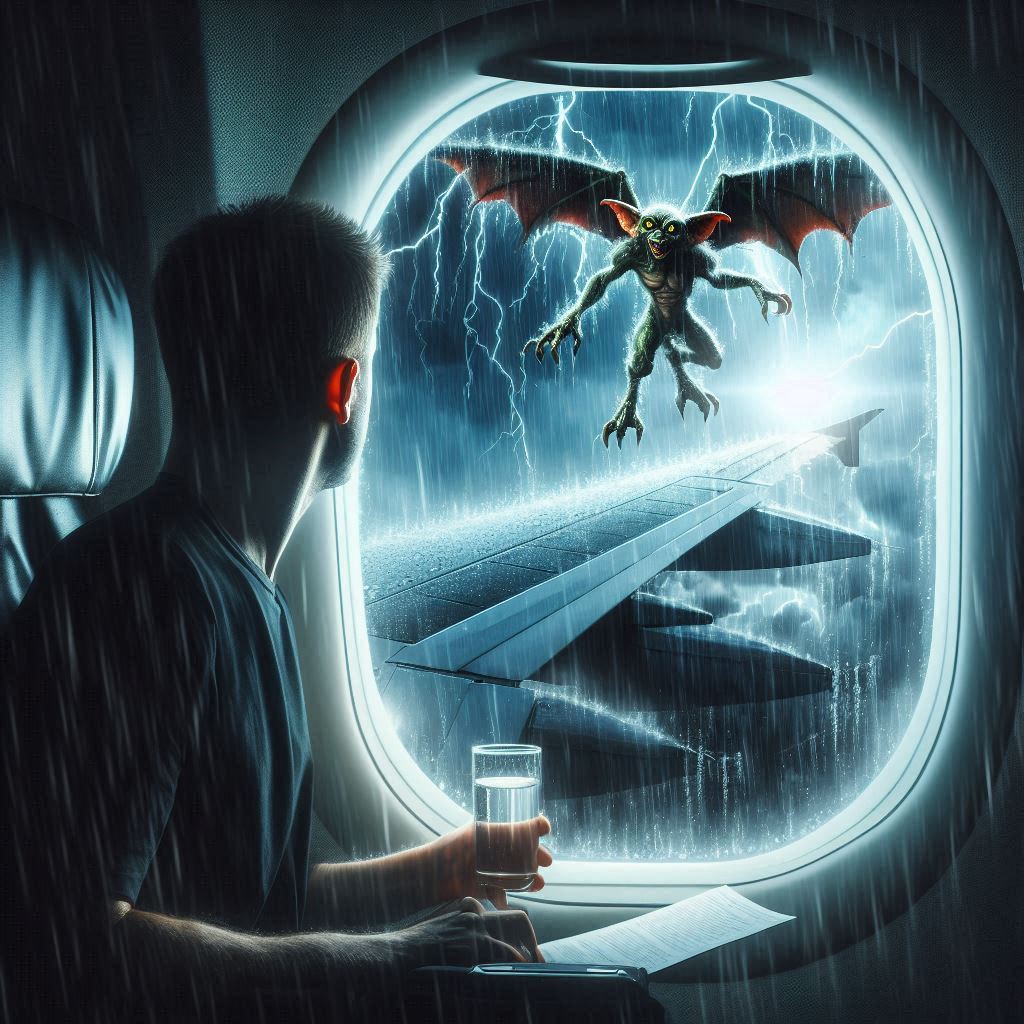The Gremlin
Fear of Mischief and Sabotage
Jump to the Article

The Gremlin is a mischievous, almost always malevolent, creature, most famously known for sabotaging aircraft in the air when we are most dependent upon the machines, and most vulnerable. Lurking in the wires, playing with our fears, esploiting our secrete mistrust of the machines we invent, the gremlin is a master at foiling our greatest achievements and ambitions.
They say technological progress liberates us. But progress, my friends, is a gilded cage. For with each gleaming machine, each intricate network of wires, we invite them in. The gremlins.
They are not of this world, these creatures of shadow and spite. Born in the abyss of discarded technology, they thrive on the anxieties that fuel our modern lives.
You see, the gremlin understands. It knows that our safety, our very survival, now hinges on a delicate dance of electricity and algorithms. A missed signal, a corrupted code, and the world can unravel.
And so, it waits. Patient, insidious.
The gremlin infiltrates. It slithers through fiber optic cables, whispering doubts into the circuitry. It gnaws at the insulation, fraying the nerves of our interconnected systems.
Then, it strikes.
The autopilot veers off course, life support falters, and emergency brakes fail. As chaos erupts, the gremlin feasts. It revels in the screams, panic, and shattered trust in the very machines that were meant to protect us.
For the gremlin knows that true fear, the kind that chills you to the bone, is not born of the unknown. It is born of the betrayal of the known. Of the systems we built to conquer nature, turning against us.
So, remember the gremlin the next time you board a plane, rely on a self-driving car, or slip into the comforting embrace of a hospital bed. Lurking in the wires, waiting for its chance to strike. And pray that your faith in progress does not become your undoing.
A Little History
Originating in Royal Air Force slang during World War II, the term "gremlin" provided pilots with a humorous scapegoat for inexplicable mechanical failures. These mischievous imps quickly entered popular culture, symbolizing the unexpected and the frustrations of technology. Their image has been immortalized in literature, film, and even in the design of aircraft components, solidifying their place as iconic figures of folklore and a reminder of the unpredictable nature of both machines and human endeavor.
Of course, these monsters are fictional. We humans invent gremlins to escape responsibility when our trusted machines fail us. Everyone knows gremlins are not real.
Or, are they?
What Happened to the Mars Rover, Spirit?
The Mars Rover, Spirit, was designed to operate for 90 sols (Martian days). Instead, it defied all expectations, exploring the Red Planet for over six years. However, communication with Spirit was abruptly lost during a particularly intense dust storm.
Engineers were baffled. The rover was equipped with sophisticated systems to withstand such events. Every sensor and circuit had been meticulously tested and redundantly designed. Yet, something had gone wrong.
Days turned into weeks, and Spirit's silence grew more ominous. Theories ranged from a catastrophic hardware failure to a software glitch, but none of the explanations seemed to fully capture the bizarre nature of the event.
Then, whispers began to circulate among the engineers: "Gremlins."
The idea was dismissed as superstition at first. But the whispers grew louder as the days wore on and no logical explanation emerged. The dust storm, they argued, had not just damaged the rover; it had provided an opening. A gateway for the unseen, the mischievous.
The gremlin, it was theorized, had found a weakness in the rover's intricate systems, a single, seemingly insignificant component. It had tampered with it, not to destroy but to torment. To taunt the engineers with the illusion of functionality before plunging the rover into an agonizing silence.
Of course, this was never the official explanation. But among the engineers who had poured their hearts and souls into Spirit, the legend of the Martian gremlin persisted. It was a chilling reminder of the limits of human understanding and the humbling realization that sometimes, the most inexplicable failures defy all logic.
Sources
- "Gremlin" - Wikipedia. Accessed January 17, 2025.
- "Mechanical mischief makers" - RAF Museum. Accessed January 17, 2025.
- "Gremlins Were A Pilot's Worst Enemy During World War II" by Clare Fitzgerald. War History Online. Accessed January 17, 2025.
- "WWII Gremlins: Mischievous Saboteurs or Mythical Saviors?" by Wade Beaumont. Hanger 1 Publishing. Accessed January 17, 2025.
